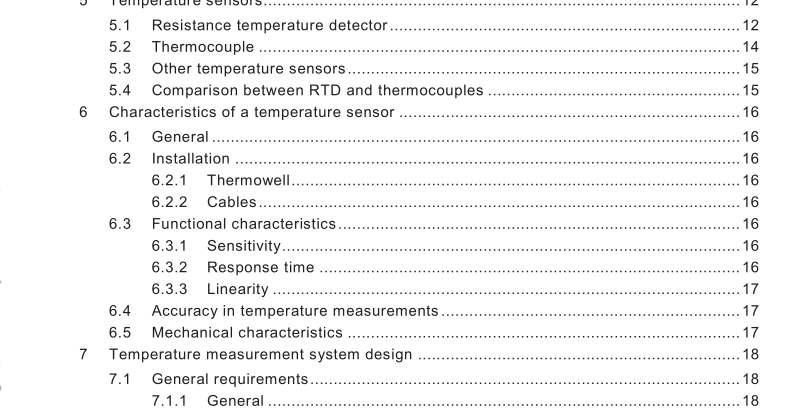BS IEC 60737:2010 pdf download – Nuclear power plants – Instrumentation important to safety – Temperature sensors (in-core and primary coolant circuit) – Characteristics and test methods
4 General considerations
4.1 Requirements for temperature measurements Temperature is a fundamental parameter related to the nuclear process in a reactor. It can be measured with specific sensors to perform the following main safety functions:
– to monitor the temperature of the cooling system and to follow the operating conditions with regard to the design parameters;
– to measure the thermal power of the reactor when the temperature measurement is combined with the coolant flow rate measurement;
– to monitor the temperature of the fuel elements in order to avoid a boiling incident or melting of the fuel element itself. Temperature measurements are required from the fuel, moderator, coolant or structural members supporting the core. They are used for control purposes, for the protection system, for shut-down and accident monitoring or for the provision of more general information about the reactor or its components.
In a power reactor with a core which has large physical dimensions, it may be important to monitor not only mean temperatures but also spatial temperature distributions. Measurements at particular positions may be used for the control of specific parts of the reactor core to ensure adequate safety margins for protection system parameters or to provide for optimum fuel utilization. Some in-core measurements may also be necessary for reasons such as protecting the fuel from damage caused by local disturbances in coolant flow or by transients in local power density.
In most cases, temperature sensors are used to measure temperature directly, but applications do arise in which information is derived from fluctuations in temperature. An example of the latter is the derivation of coolant flow by correlation of the fluctuations obtained from a spaced pair of sensors. The measurement of in-core temperature for water reactors is important for reactor efficiency and fuel burn up, and may be achieved through probes inserted into specific channels of the reactor, or by permanently installed detectors.
The measurements of these sensors are normally taken at routine intervals, followed by calculations to assess the conditions at each monitored fuel channel. In all these applications, the environment is demanding and the performance of the temperature measurement system is either important to safety or to operation. The temperature signals may be measured in a continuous or discontinuous manner depending on the application. This will not usually affect the design of the in-core installation.
4.2 Safety applications Temperature sensors used in a system performing safety functions classified according to IEC 61 226 shall follow the associated safety requirements determined by the safety class of the functions. If the measurements are important to safety, the cable routes shall also satisfy separation requirements to meet relevant single failure criteria and to avoid common cause failures, see IEC 60709. After an accident, the cooling of fuel elements may decrease and the temperature inside the fuel may increase dramatically.
A fuel element melt may occur and, when the coolant is water, a chemical reaction between the cladding and water produces a large quantity of hydrogen. The post accident conditions should be monitored by using temperature measurements capable of withstanding very high temperatures (for example, higher than 1 1 00 °C for light water reactors). The maximum temperature to be measured and the locations of the temperature sensors shall be specified by the designer of the reactor.
4.3 Nuclear conditions The nuclear conditions related to the coolant circuit or inside the reactor vessel are very specific and different from general industry conditions. These conditions are characterized by the following:
– High radiation dose rates induced by gamma and neutrons, noting that:
• high gamma dose rates damage organic materials by changing the molecular links;
• fast neutrons damage organic and mineral materials by changing the atomic structure. This phenomenon can cause a change in characteristics;
• thermal neutrons induce activation.
